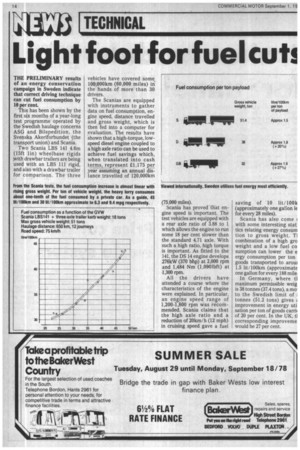Light foot for fuel cuts
Page 16

If you've noticed an error in this article please click here to report it so we can fix it.
THE PRELIMINARY results of an energy conservation campaign in Sweden indicate that correct driving technique can cut fuel consumption by 10 per cent.
This has been shown by the first six months of a year-long test programme operated by the Swedish haulage concerns ASG and Bilspedition, the Svenska Akeriforbundet (the transport union) and Scania.
Two Scania LBS 141 4.6m (15ft lin) wheelbase rigids with drawbar trailers are being used with an LBS 111 rigid, and also with a drawbar trailer for comparison. The three vehicles have covered some 100,000km (60,000 miles) in the hands of more than 30 drivers..
The Scanias are equipped with instruments to gather data on fuel consumption, engine speed, distance travelled and gross weight, which is then fed into a computer for .evaluation. The results have shown that a high-torque, lowspeed diesel engine coupled to a high axle ratio can be used to achieve fuel savings which, when translated into cash terms, represent £1,175 per year assuming an annual distance travelled of 120,000km (75,000 miles).
Scania has proved that engine speed is important. The test vehicles are equipped with a rear axle ratio of 3.88 to 1 which allows the engine to run some 18 per cent slower than the standard 4.71 axle. With such a high ratio, high torque is important. As fitted to the 141, the DS 14 engine develops 276kW (370 bhp) at 2,000 rpm and 1,484 Nm (1,0901bft) at 1,300 rpm.
All the drivers have attended a course where the characteristics of the engine were explained. In particular, an engine speed range of 1,200-1,800 rpm Was recommended. Scania claims that the high axle ratio and a reduction of 20km/h (12 mph) in cruising speed gave a fuel saving of '10 lit/1001 (approximately one gallon le for every 28 miles).
Scania has also come with some interesting stat tics relating energy consum tion to gross weight. TI combination of a high gro weight and a low fuel co sumption can lower the e ergy consumption per ton goods transported to aroui 1.5 lit/100km (approximate one gallon for every 188 mile In Germany, where ti maximum permissible weig is 38 tonnes (37.4 tons), a ma to the Swedish limit of tonnes (51.2 tons) gives improvement in energy uti sation per ton of goods carrii of 20 per cent. In the UK, tl corresponding improveme would be 27 per cent.




































































































